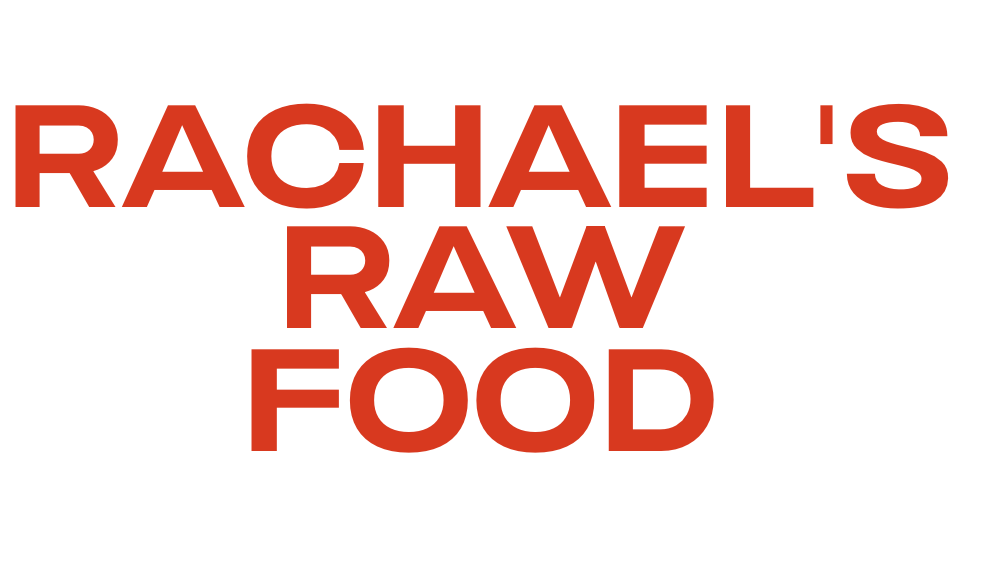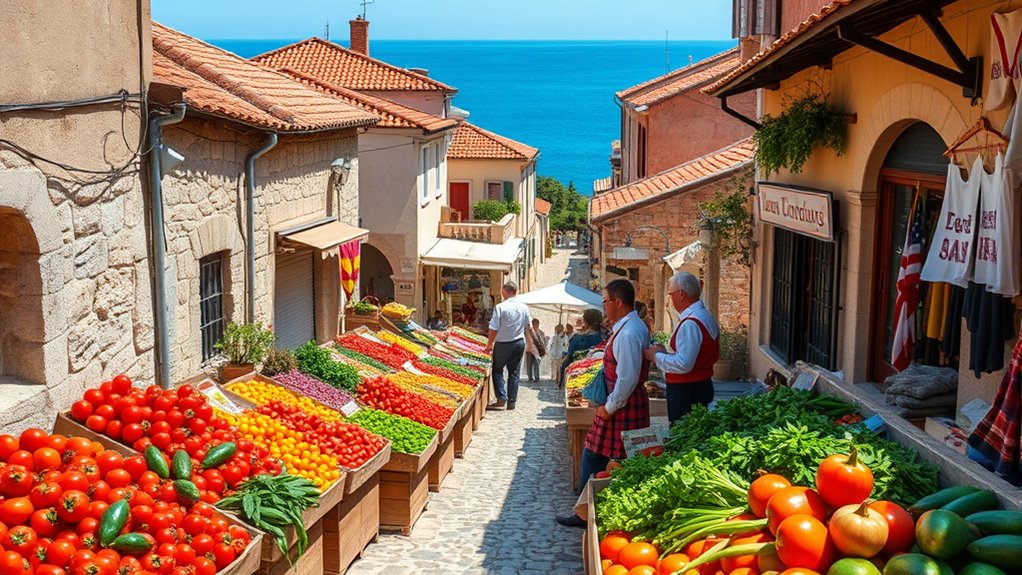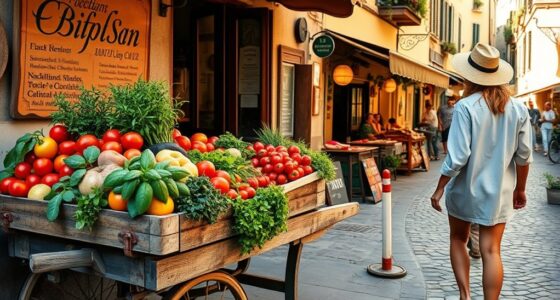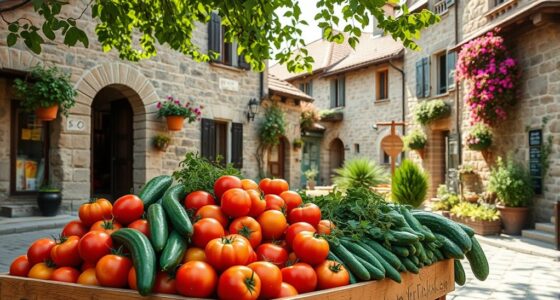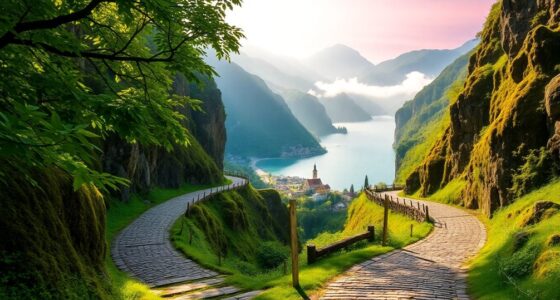On Croatia’s Dalmatian Coast, you’ll find lively markets from Zadar to Dubrovnik bursting with fresh seafood, aromatic herbs, cheeses, honey, and handcrafted souvenirs. In Zadar, the vibrant markets showcase regional flavors and daily life, while Split’s ancient Diocletian’s Palace blends history with modern market energy. Dubrovnik’s Old Town markets offer unique crafts and wines amid stunning architecture. Exploring these markets reveals the region’s rich culture and traditions—there’s much more to discover beyond the surface.
Key Takeaways
- Vibrant markets in Zadar, Split, Makarska, and Dubrovnik showcase fresh seafood, local cheeses, herbs, and handcrafted goods.
- Markets serve as cultural hubs, offering authentic flavors, regional specialties like peka, and lively local interactions.
- Zadar’s markets highlight Dalmatian flavors with aromatic seafood and spices, reflecting the region’s culinary heritage.
- Dubrovnik’s markets blend history and local craftsmanship, featuring souvenirs, wines, and traditional crafts against medieval scenery.
- Markets along the coast embody Croatian culture, connecting visitors to the region’s rich history, food traditions, and vibrant daily life.
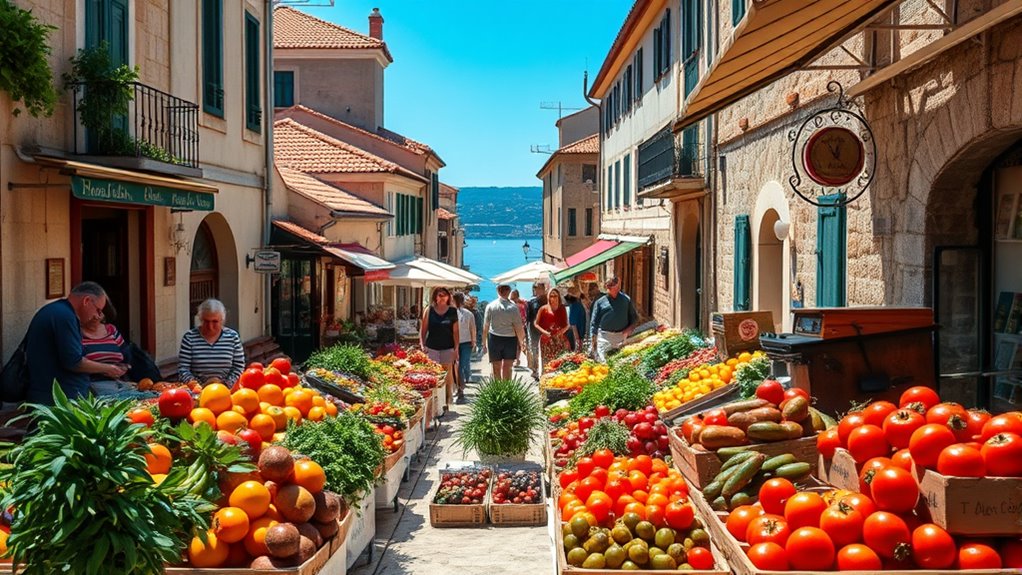
Are you ready to discover one of Europe’s most stunning coastal regions? The Dalmatian Coast of Croatia offers an incredible blend of vibrant markets, rich history, and breathtaking scenery that will enthrall your senses from Zadar to Dubrovnik. As you explore these lively markets, you’ll quickly notice the aroma of fresh seafood, fragrant herbs, and local delicacies wafting through the air. These markets are more than just places to buy produce; they’re the heart of local life, where vendors display colorful arrays of fruits, vegetables, cheeses, and handcrafted goods. You’ll find yourself immersed in the authentic Croatian experience, sampling regional specialties and chatting with friendly vendors enthusiastic to share their stories.
Starting in Zadar, you’ll encounter markets that burst with energy and authenticity. Here, the local cuisine takes center stage, offering traditional dishes like fresh calamari, octopus salad, and peka—meat or seafood slow-cooked under a bell-like dome. The markets are also dotted with stalls selling local olive oils, honey, and aromatic spices, giving you a taste of Dalmatian flavors. As you move southward, the historic landmarks in each city become as mesmerizing as the markets themselves. In Split, the ancient Diocletian’s Palace looms above the bustling streets, blending Roman architecture with lively modern life. Walking through its labyrinthine corridors, you’ll get a sense of history that’s alive and well, echoing stories from centuries past.
Experience Zadar’s vibrant markets and historic Split’s Roman charm blending tradition and modern life.
Further along the coast, the markets in Makarska and Dubrovnik showcase a different yet equally compelling side of Dalmatia. Dubrovnik’s Old Town is a UNESCO World Heritage site filled with historic landmarks like the massive city walls, forts, and churches that tell stories of medieval grandeur. The markets here are perfect for picking up souvenirs, handmade crafts, and local wines, all set against the backdrop of stunning architecture. Throughout your journey, you’ll notice how these markets serve as gateways to understanding Croatian culture—an ongoing conversation between history, tradition, and everyday life. Incorporating appliance maintenance plans or energy-efficient appliances is uncommon but can help preserve some of the local environment’s natural beauty by reducing waste and energy consumption.
Visiting the Dalmatian Coast isn’t just about sightseeing; it’s about immersing yourself in the local way of life. The markets provide a vibrant, authentic experience that allows you to taste the region’s culinary treasures and appreciate its deep-rooted history. Every stall, every dish, and every landmark tells a story, inviting you to become part of Croatia’s living heritage. So, whether you’re savoring a fresh seafood platter or wandering through ancient streets, you’ll find that the Dalmatian Coast’s markets are truly a reflection of its rich, enduring spirit.
Frequently Asked Questions
What Are the Best Months to Visit Croatia’s Dalmatian Coast?
The best visiting months for Croatia’s Dalmatian Coast are May, June, September, and October. During these months, you’ll enjoy pleasant weather and fewer seasonal crowds, making it easier to explore markets from Zadar to Dubrovnik. Summer months can be crowded and hot, so visiting in the shoulder seasons helps you experience the region’s beauty without the peak-season hustle. Plan your trip during these times for a more relaxed and enjoyable experience.
How Safe Is It to Travel Alone Along the Coast?
Traveling alone along Croatia’s Dalmatian Coast is generally safe if you follow local safety tips. Solo travel safety is high, especially in popular tourist areas like Zadar and Dubrovnik. Stay aware of your surroundings, avoid poorly lit areas at night, and keep your belongings secure. Trust local advice, use reputable transportation, and stay connected with friends or family. With precautions, you can enjoy a safe and memorable solo adventure.
Are There Any Local Festivals Unique to Dalmatia?
Think of Dalmatia’s festivals like vibrant mosaics, each piece representing local folk traditions and seasonal celebrations. You’ll find unique events like the Sinjska Alka, a medieval jousting tournament in Sinj, and the Feast of St. Blaise in Dubrovnik. These festivals showcase Dalmatia’s rich culture, with lively music, dance, and customs that give you an authentic taste of local life. Don’t miss these colorful, unforgettable celebrations when you visit!
What Currency Is Used in Croatia’s Dalmatian Coast?
You’ll find that Croatia’s Dalmatian Coast uses the Croatian Kuna as its currency. When you do currency exchange, it’s best to use local banking options or official exchange offices to get the best rates. Cash is widely accepted, but many places also take credit cards. Make sure to keep some Kuna on hand for small purchases or markets where cash is preferred. Always check the latest exchange rates before you travel.
How Accessible Are the Islands From the Mainland?
You can easily reach the islands from the mainland, as ferries run frequently across shimmering blue waters, creating a seamless connection. Ferry schedules are reliable, making island transportation straightforward whether you’re heading to secluded coves or lively towns. Visualize hopping aboard a boat, feeling the sea breeze, and watching the coastline shrink behind you. This accessibility invites you to explore Croatia’s stunning islands effortlessly, immersing yourself in their charm and vibrant life.
Conclusion
As you explore Croatia’s enthralling coast, let its lively markets liven your senses and linger in your memories. From Zadar’s zestful stalls to Dubrovnik’s dazzling displays, each marketplace promises picturesque panoramas and passionate people. Embrace the energy, enjoy the eclectic encounters, and let the vibrant vibes of Dalmatia’s markets mark your journey with memorable moments. Immerse yourself in the delightful chaos, and you’ll discover a destination that’s as dynamic as it is divine.
